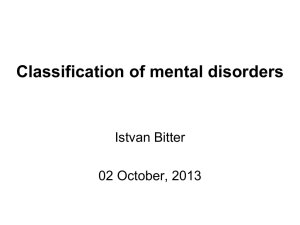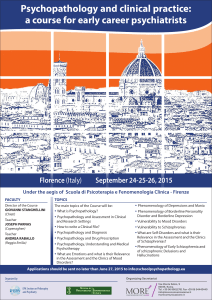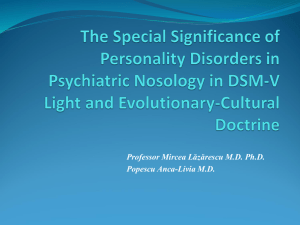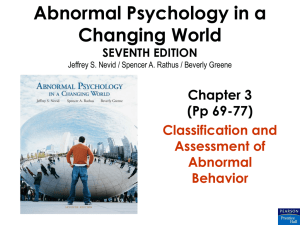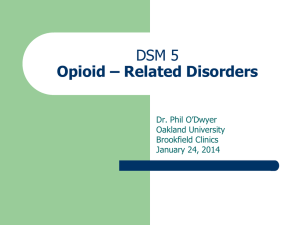Ch02 - Myweb @ CW Post
advertisement
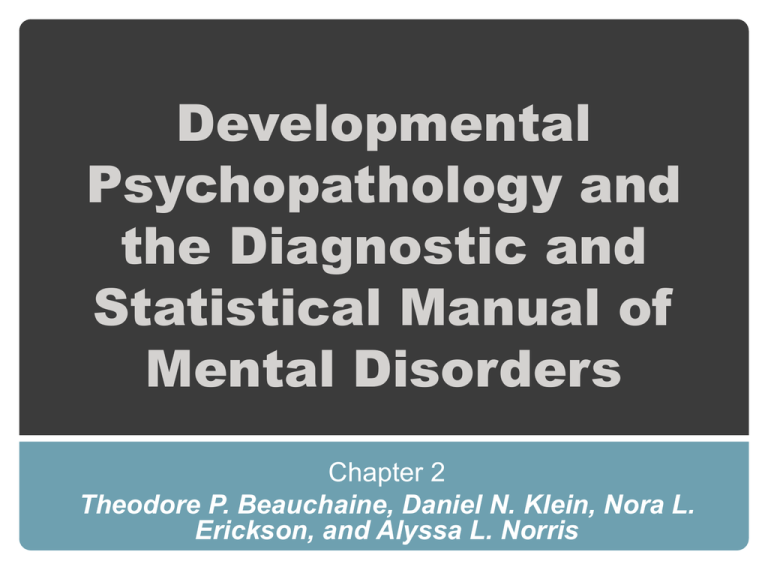
Developmental Psychopathology and the Diagnostic and Statistical Manual of Mental Disorders Chapter 2 Theodore P. Beauchaine, Daniel N. Klein, Nora L. Erickson, and Alyssa L. Norris HISTORICAL CONTEXT Early Versions of the DSM The DSM-I (APA, 1952) An effort by the APA to produce a single nomenclature for psychopathology. Influenced strongly by Adolph Meyer's psychobiology, which viewed psychopathology as a reaction to stress. Three broad classes of psychopathology included organic brain syndromes, functional disorders, and mental deficiency. 108 specific diagnoses with only one applied to children. Little basis in empirical research. HISTORICAL CONTEXT The DSM-II (APA, 1968) • Major goal was to improve communication among mental health professionals—especially psychiatrists. • Strong psychoanalytic influences. • Major diagnostic classes of psychopathology were expended from 3 to 11. • A number of childhood and adolescent disorders were added. • The seventh printing of the DSM-II (APA, 1974), homosexuality was removed as a mental disorder. RELIABILITY, VALIDITY, AND SUBSEQUENT VERSIONS OF THE DSM The DSM-III (APA, 1980) • Designed to be descriptive and largely atheoertical, so it would be useful to professionals from a variety of disciplines. • Clinical features and etiology of major forms of psychopathology were important influences reducing the strong psychoanalytic overtones of prior versions of the DSM. • Diagnosis played a central role as a reliable and valid classification system. RELIABILITY, VALIDITY, AND SUBSEQUENT VERSIONS OF THE DSM Limited evidence of inter-rater reliability of psychiatric diagnosis, a major obstacle for reliable diagnosis • Problems with reliability: • Rates of various diagnoses differed dramatically between the United States and most European countries. • Studies addressing diagnostic reliability indicated very low inter-rater agreement. RELIABILITY, VALIDITY, AND SUBSEQUENT VERSIONS OF THE DSM Operationalizing Diagnostic Criteria: Reducing Criterion Variance Feighner Criteria (1972) stated that diagnostic validity can be established when a clinical syndrome is characterized by: • A cluster of covarying symptoms and etiological precursors (obtained from clinical description) • Reliable physiological, biological, and/or psychological markers obtained from clinical description) • Readily definable exclusionary criteria • Predictable course (assessed through follow-up studies) • Increased rates of the same disorder among first-degree relatives (assessed through family studies). RELIABILITY, VALIDITY, AND SUBSEQUENT VERSIONS OF THE DSM Structured Interviews: Reducing Information Variance Present State Examination (PSE): A systematic assessment of patients' current symptoms. It did not collect information on previous history. Schedule for the Affective Disorders and Schizophrenia (SADS): Allowed clinicians to collect systematic and reliable data on both current symptoms and history of most major psychiatric disorders. RELIABILITY, VALIDITY, AND SUBSEQUENT VERSIONS OF THE DSM Structured Clinical Interview for DSM-III (SCID): Assessed all major disorders in the DSM-III and was less time consuming than the PSE and the SADS. Diagnostic Interview Schedule (DIS): A respondent-based measure designed for use by nonclinicians leaving no room for interviewer judgment in formulating questions and rating symptoms. Diagnostic Interview Schedule for Children (DISC): assesses DSM-IV-TR (APA, 2000) psychiatric disorders, designed for use with parents of children ages 6 to 17 and with children and adolescents ages 9 to 17. RELIABILITY, VALIDITY, AND SUBSEQUENT VERSIONS OF THE DSM The DSM-III, DSM-III-R, and DSM-IV The DSM-III (APA, 1980) • The first official classification system in psychopathology that used specific symptoms, including inclusion, exclusion, and duration criteria for each diagnosis. • Multiaxial classification addressed patients’ uniqueness in making a diagnosis. • Axis I: Major psychiatric syndromes • Axis II: Personality disorders • Axis III: Physical conditions that are relevant to understanding a person’s presenting problem • Axis IV: Psychosocial and environmental stressors and problems • Axis V: And overall severity, or global assessment of functioning (GAF) RELIABILITY, VALIDITY, AND SUBSEQUENT VERSIONS OF THE DSM DSM-III-R (APA, 1987) • Exclusion criteria were eliminated from the DSM-III-R, except those used to rule out an organic causes of disorder. • The elimination of exclusion criteria lead to an increase in rates of comorbidity, or the co-occurrence of two or more disorders. DSM-IV (APA, 1994) • Revisions were more data driven than in previous versions, and the process was more systematic and better documented. DSM-IV-TR (APA, 2000) • Factual errors were corrected; sections of text describing each diagnostic category, associated features, advances in laboratory and clinical research, etc., were revised based on new research. THE DSM AND DEVELOPMENTAL PSYCHOPATHOLOGY Criticisms of the DSM Approach Problems with construct validity • Construct validity refers to the extent to which symptoms of a diagnosis mark an objective, nonarbitrary entity that relates to mental health outcomes. Heterogeneity within diagnostic classes • Equifinality states that diverse etiologies often result in what appears to be a single disorder. However, since DSM diagnoses are all derived syndromally different underlying causes of a disorder may never be ascertained. Categorical versus dimensional measurement • Overly categorical diagnosis losses information about individual differences in symptoms, difficulty ascertaining optimal diagnostic cut offs and loss of statistical information. THE DSM AND DEVELOPMENTAL PSYCHOPATHOLOGY Criticisms of the DSM Approach • Failure to consider development • Child and adolescent psychopathology are assessed and diagnosed without careful consideration of normative developmental trends in behavior, and without acknowledgement that of Heterotypic continuity, meaning a single behavioral traits—including those that confer vulnerability to psychopathology—may be expressed differently at different ages. • The Axis I-Axis II distinction • Basis for the distinction between Axis I and Axis II often seems arbitrary and some forms of severe personality disorders share the same etiologiological influences as Axis I disorders. • The assumption that personality disorders can only be diagnosed among adults. • Failure to consider culture and other contextual issues • Does not account for culturally induced individual differences in behavior that might be mistaken for psychopathology or cultural, socioeconomic, and other contextually driven individual differences in the expression of psychopathology. CHANGES TO THE UPCOMING DSM-5 Structural changes The 20 chapters are sequenced developmentally, with disorders usually diagnosed in infancy listed first, followed by disorders of childhood, adolescence, and adulthood. Personality disorder revisions The number of personality disorders are reduced from 10 to 6 and ratings in three different areas are used to diagnose personality pathology. Multiaxial system Three Axes: • Axis I (psychiatric and medical diagnoses): Will included the DSM-IV-TR Axes I (clinical disorders) II (developmental and personality disorders) and III (general medical conditions). • Axis II: will include Axis IV of the DSM-IV-TR (psychosocial and environmental problems). • Axis III: will include Axis V of the DSM-IV-TR (global assessment of functioning). CONCLUSIONS Although the DSM is an important component of mental health diagnosis there are still many limitations that fail to: Capture developmental processes underlying current and future risk for psychopathology. Specify pathophysiological and etiological mechanisms of psychopathology. Map broad biobehavoioral traits that predispose to psychopathology across traditional diagnostic boundaries. Account fully for contextual influences such as ethnicity and culture on the development of psychopathology.
